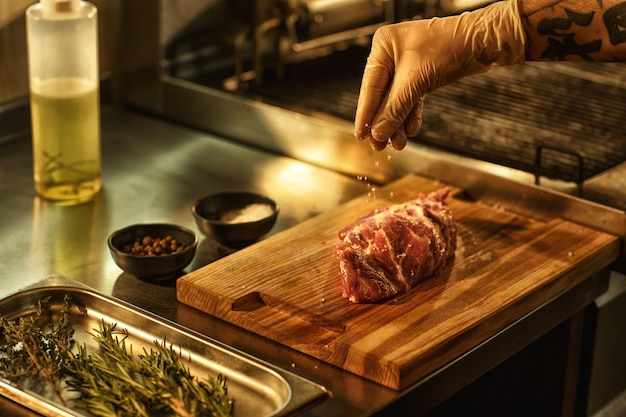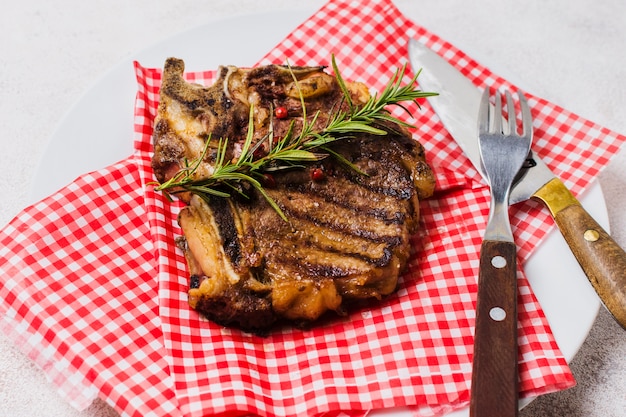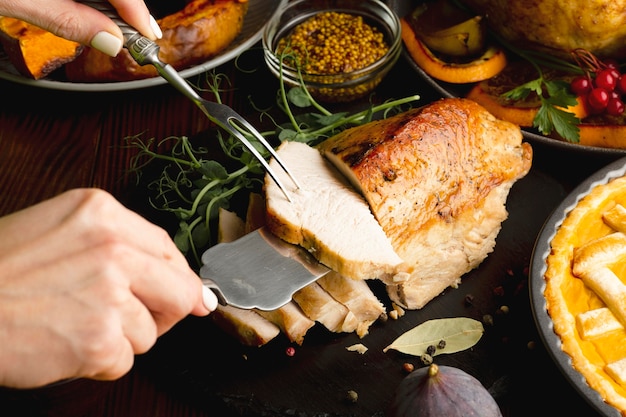There's a reason why prime rib is the king of roasts. It's a showstopper, a culinary masterpiece that demands respect and attention. But let’s be honest, mastering the art of the perfect prime rib roast can feel like a daunting task. I’ve been there, with more than my fair share of dry, tough prime rib mishaps. But trust me, after years of trial and error, I've discovered the secrets to achieving that melt-in-your-mouth, succulent roast that will have your guests begging for seconds.
This isn’t just another recipe. This is an adventure, a culinary journey we’ll embark on together. We’ll delve into the intricacies of choosing the right cut, mastering the art of seasoning, and conquering the oven. We’ll explore various cooking methods, from classic techniques to innovative approaches, and unravel the importance of resting and carving. By the end of this guide, you’ll have the confidence to create a prime rib roast that will leave everyone speechless. So, grab your apron, crank up your favourite playlist, and let’s dive in!
(Part 1) Setting the Stage: Choosing the perfect prime rib

The journey to a perfect prime rib starts at the butcher's counter. Choosing the right cut is like selecting the perfect canvas for your culinary masterpiece. Here's how to make sure you pick the perfect cut:
The Cut: Bone-In vs. Boneless
You'll find two main contenders at the butcher:
- standing rib roast: This is the classic choice, a bone-in roast that comes from the rib section of the cow. Typically 3-4 ribs long, it boasts a beautiful, marbled texture and a rich, deep flavour. The bones add a unique flavour to the roast, and let’s be honest, it just looks so much more impressive!
- Rib Roast (boneless): This is essentially the same as the standing rib roast, minus the bones. It’s slightly more convenient for carving and might be easier to cook evenly.
Personally, I’m a huge fan of the standing rib roast. There's something about that impressive bone-in presentation that just makes a statement. But if you prefer the convenience of a boneless roast, it’s a perfectly acceptable choice.
Weight: How Much is Enough?
The weight of your roast dictates how long it takes to cook and how many hungry mouths it will satisfy. A good rule of thumb is to plan for about 1 pound of prime rib per person. If you’re expecting a crowd, don't hesitate to go for a larger roast. Leftovers are always a good thing!
Marbling: The Key to Juiciness
Marbling, those beautiful streaks of fat throughout the meat, is the secret weapon of a truly delicious prime rib. It’s what gives the roast its incredible flavour and tenderness. When choosing your roast, look for good marbling, particularly around the edges. The more marbling, the juicier and more flavourful your roast will be. Remember, don’t skimp on the marbling! It’s worth the extra pennies.
(Part 2) The Art of Seasoning: A Symphony of Flavors

Now that you’ve got your prized prime rib, it's time to unleash your inner seasoning maestro. The goal is to create a symphony of flavors that enhances the natural richness of the meat without overpowering it.
My Go-To Seasoning Blend
This blend is my tried-and-true secret weapon for almost every roast:
- Kosher salt: The foundation of any good seasoning blend. Don’t be shy with the salt; it will draw moisture out of the meat, then reabsorb it during cooking, creating a beautifully juicy roast.
- Freshly ground black pepper: This is a no-brainer. Freshly ground black pepper adds a punch of flavor that you just won't find with the pre-ground stuff.
- Garlic powder: A subtle touch of garlic powder adds a depth of flavour and richness to the roast.
- Onion powder: Just like garlic powder, a small amount of onion powder provides a subtle sweetness that complements the richness of the meat.
But don’t stop there! You can experiment with other spices, herbs, and aromatics to create your own unique seasoning blend. Rosemary, thyme, paprika, a pinch of cayenne pepper for a kick – the possibilities are endless! Just remember, keep the flavours balanced and let the natural flavour of the prime rib shine through.
The Importance of Time
Don’t just slap your seasoning on the roast and throw it in the oven. Patience, my friend, is key! Allow the seasoning to sit on the meat for at least 30 minutes, preferably an hour or two. This gives the salt time to work its magic, drawing out moisture and creating a beautifully crispy crust. Trust me, the longer you let the seasoning sit, the more flavourful your roast will be.
(Part 3) Mastering the Oven: The perfect roast

The oven is the stage where your prime rib roast takes centre stage. It’s here where the real magic happens. But before you crank up the heat, there are a few important things to consider to ensure your prime rib shines.
Temperature is King
The temperature at which you cook your prime rib determines its fate. The general rule of thumb is to start with a high temperature, about 450°F (232°C), for the first 15 minutes. This will create that beautiful, crispy crust we all crave. After that, reduce the temperature to 325°F (163°C) and continue cooking until the roast reaches your desired level of doneness.
Doneness: Finding Your Sweet Spot
Here’s a quick guide to internal temperatures for prime rib, but remember, these are just guidelines. Your personal preference for doneness may vary. So use a meat thermometer to check the internal temperature of your roast and adjust cooking time accordingly.
| Doneness | Internal Temperature |
|---|---|
| Rare | 125°F (52°C) |
| Medium Rare | 130°F (54°C) |
| Medium | 140°F (60°C) |
| Medium Well | 150°F (66°C) |
| Well Done | 160°F (71°C) |
The Resting Ritual: A Must-Do
After your prime rib has reached perfection in the oven, resist the urge to carve immediately. Let it rest for at least 15 minutes, covered with foil, before slicing. This crucial step allows the juices to redistribute throughout the meat, resulting in a more tender and flavourful roast. Trust me, the extra few minutes of patience will be worth it.
(Part 4) Beyond the Basics: Exploring Different cooking techniques
Now that we’ve covered the fundamental principles of prime rib roasting, let’s explore some more adventurous techniques. These methods can take your prime rib game to a whole new level.
reverse searing: A Masterclass in Tenderness
This technique involves cooking the roast at a low temperature for a longer period of time before searing it at a high temperature. The result? A roast that's incredibly tender and juicy throughout, with a perfectly crisp exterior. It's a bit of a culinary magic trick.
Here's how it works:
- Preheat your oven to 225°F (107°C).
- Place the seasoned roast on a roasting rack in a baking pan.
- Cook for about 2 hours, or until the internal temperature reaches about 120°F (49°C) for medium rare.
- Remove the roast from the oven and let it rest for 15 minutes.
- Preheat your oven to 500°F (260°C).
- Place the roast back in the oven and sear for 10-15 minutes, or until the crust is beautifully browned and crispy.
sous vide cooking: Precision and Consistency
Sous vide cooking is all about precision and consistency. It involves sealing the roast in a vacuum bag and immersing it in a water bath at a specific temperature for a set time. This method ensures that the roast cooks evenly throughout, resulting in a perfectly cooked prime rib every time.
Here’s the basic process:
- Season the roast and place it in a vacuum bag.
- Set your water bath to 130°F (54°C) for medium rare.
- Immerse the bag in the water bath for 2-3 hours, or until the internal temperature reaches 130°F (54°C).
- Remove the roast from the bag and pat it dry.
- Sear the roast in a hot pan or under a broiler for a few minutes on each side to create a crispy crust.
Smoked Prime Rib: A Symphony of Smoke and Flavor
For an extra layer of flavour, try smoking your prime rib. It's a bit more involved, but the smoky aroma and taste are truly incredible. There are a few ways to smoke your prime rib, from using a dedicated smoker to building a fire pit in your backyard. Regardless of the method you choose, the key is to use a low and slow approach, smoking the roast for several hours at a temperature of around 225°F (107°C).
You can use a variety of woods for smoking, each adding its own unique flavour profile. Hickory, mesquite, or applewood are popular choices. Experiment with different woods to find your favourite combination. Your guests will be impressed by the smoky aroma and taste.
(Part 5) The Grand Finale: Carving and Serving Your prime rib masterpiece
You've conquered the oven and your prime rib is cooked to perfection. Now it's time for the final act - carving and serving your culinary masterpiece.
Carving with Confidence
Carving a prime rib might seem intimidating, but with a little practice, it's surprisingly straightforward. Here's what you need to do:
- Sharp Tools are Essential: Use a sharp carving knife. A dull knife makes the process frustrating and can lead to uneven slices.
- Secure Your Roast: Place the roast on a carving board, making sure it's secured so it doesn’t slide around. You want a stable base to work with.
- Between the Bones: For a standing rib roast, carve between the bones, slicing along the bone to release the meat.
- Against the Grain: Slice the roast against the grain. This will help make the meat more tender and easier to chew.
- Leave the Bones In: If you’re serving the roast with the bone in, leave the bones in place for presentation purposes. It adds a touch of rustic charm and helps keep the roast warm.
The Perfect Accompaniments: Elevating the Feast
No prime rib feast is complete without the right accompaniments. Here are some classic sides that will make your prime rib shine:
- Roasted Potatoes: A timeless pairing that complements the richness of the roast.
- Creamed Spinach: A creamy and decadent side that adds a touch of elegance to the table.
- Asparagus: Fresh, crisp asparagus adds a welcome contrast to the richness of the roast.
- Yorkshire Pudding: A traditional British side dish that’s perfect for soaking up the juices from the roast.
Don’t forget a good red wine to go with your prime rib. A Cabernet Sauvignon or a Merlot would be a perfect choice.
(Part 6) The Art of Leftovers: Making the Most of Your Prime Rib Treasure
You’ve nailed the prime rib roast, fed your guests, and now you’re left with glorious leftovers. Don’t despair! prime rib leftovers are a culinary goldmine, waiting to be transformed into delicious new creations.
Leftover Prime Rib Heaven: Beyond the Sandwich
Think beyond simple sandwiches. You can transform your leftover roast into a variety of delicious dishes, including:
- Prime rib hash: Dice the leftover roast and sauté it with potatoes, onions, and peppers for a hearty and satisfying meal.
- Prime rib salad: Slice the leftover roast and add it to a salad with greens, vegetables, and a dressing of your choice.
- Prime rib soup: Combine the leftover roast with broth, vegetables, and herbs for a comforting and flavorful soup.
- Prime rib pizza: Use the leftover roast as a topping for your favourite pizza.
The possibilities are endless. Get creative and experiment with different recipes. Your taste buds will thank you!
(Part 7) Prime Rib Mishaps: Lessons Learned and How to Avoid Them
We’ve all been there. You’ve poured your heart and soul into preparing the perfect prime rib roast, only to be met with a disappointing result. Don’t worry, we've all had our fair share of prime rib mishaps. But from those failures, we learn valuable lessons.
Dry Roast Disaster: How to Avoid It
A dry roast is a common problem, often caused by overcooking. Here's how to avoid it:
- Use a Meat Thermometer: It's your best friend in the kitchen. Cook the roast to your desired level of doneness, as indicated by the meat thermometer.
- Let it Rest: Don't skip the resting ritual! It allows the juices to redistribute throughout the meat, preventing dryness.
- Don't Overcook: Use a meat thermometer to ensure your roast isn't overcooked.
Tough Roast Tragedy: Slicing for Tenderness
A tough roast is usually the result of overcooking or using a cut of meat that isn’t suitable for roasting. Choose a roast with good marbling and cook it to your desired level of doneness. If you're still finding your roast to be tough, try slicing it thinly against the grain. This will help make the meat more tender.
Undercooked Roast Dilemma: food safety First
An undercooked roast is a food safety hazard. Use a meat thermometer to ensure that the roast is cooked to a safe internal temperature. If the roast is not cooked to the right temperature, cook it for a longer time or use a different method to cook it through.
Uneven Cooking Calamity: Rotation is Key
An unevenly cooked roast can result from using a too-high oven temperature or not rotating the roast during cooking. Cook the roast at a lower temperature and rotate it halfway through the cooking time. This will ensure that the roast cooks evenly.
(Part 8) FAQs: Answering Your Prime Rib Questions
Let's tackle some frequently asked questions about prime rib roasts.
1. Can I Freeze Prime Rib Roast?
Yes, you can freeze a prime rib roast for up to 3 months. Thaw it in the refrigerator for 2-3 days before cooking. You can also thaw it in a cold water bath, but make sure the package is sealed and submerged in water. The roast will be safe to cook after thawing, even if it’s slightly frozen.
2. What Temperature Should I Cook Prime Rib At?
Cook the roast at a high temperature, about 450°F (232°C), for the first 15 minutes to create a crispy crust. Then reduce the temperature to 325°F (163°C) and continue cooking until the roast reaches your desired level of doneness.
3. How Long Does It Take to Cook a Prime Rib Roast?
The cooking time for a prime rib roast depends on the size and weight of the roast, as well as the desired level of doneness. Generally, it takes about 15-20 minutes per pound for a rare roast, and about 20-25 minutes per pound for a well-done roast. Use a meat thermometer to check the internal temperature of the roast to ensure it is cooked to your liking.
4. What Can I Do with Leftover Prime Rib?
You can use leftover prime rib in a variety of dishes, including sandwiches, salads, soups, stews, and even pizza. Get creative and experiment with different recipes.
5. What Are the Best Wines to Pair with Prime Rib?
Red wines, such as Cabernet Sauvignon, Merlot, and Zinfandel, are great pairings for prime rib. They complement the richness of the meat and enhance its flavour. You can also try a Pinot Noir or a Syrah.
Armed with this guide, you’ll be well on your way to creating a prime rib roast that will impress even the most discerning palates. Remember, practice makes perfect, so don’t be afraid to experiment and find what works best for you. Happy roasting!
Everyone is watching

Prime Rib Roast Cooking Time Chart: Per Pound Guide
Cooking TipsPrime rib roast. Just the name conjures images of lavish dinners, crackling fires, and hearty laughter. It’s ...

How Long to Bake Potatoes in the Oven (Perfect Every Time)
Cooking TipsBaked potatoes are a staple in my kitchen. They're incredibly versatile, delicious, and surprisingly easy to m...

Perfect Rice Every Time: The Ultimate Guide to Cooking Rice
Cooking TipsAs a self-proclaimed foodie, I've always been a bit obsessed with rice. It's the foundation of countless cuisi...

The Ultimate Guide to Cooking Asparagus: Tips, Techniques, and Recipes
Cooking TipsAsparagus. The mere mention of this spring delicacy conjures up images of vibrant green spears, crisp and burs...

Ultimate Guide to Cooking the Perfect Thanksgiving Turkey
Cooking TipsThanksgiving. Just the word conjures up images of overflowing tables laden with delicious food, the scent of r...
